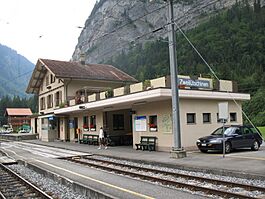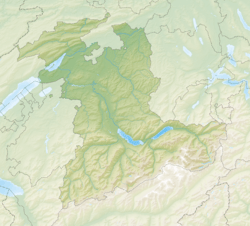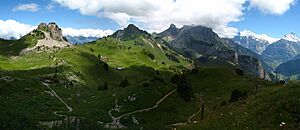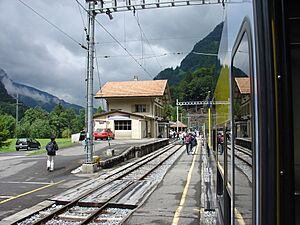Gündlischwand facts for kids
Quick facts for kids
Gündlischwand
|
||
|---|---|---|

Zweilütschinen railway station, part of Gündlischwand
|
||
|
||
| Country | Switzerland | |
| Canton | Bern | |
| District | Interlaken-Oberhasli | |
| Area | ||
| • Total | 16.84 km2 (6.50 sq mi) | |
| Elevation | 660 m (2,170 ft) | |
| Population
(Dec 2020 )
|
||
| • Total | 351 | |
| • Density | 20.84/km2 (53.98/sq mi) | |
| Postal code |
3815
|
|
| Localities | Zweilütschinen | |
| Surrounded by | Iseltwald, Lütschental, Lauterbrunnen, Gsteigwiler and Bönigen | |
Gündlischwand is a small village and municipality in Switzerland. It is located in the Interlaken-Oberhasli area of the canton of Bern. The municipality also includes a smaller village called Zweilütschinen.
Contents
History of Gündlischwand
Gündlischwand was first mentioned in old records in the year 1331. Back then, it was known as Gundlisswant.
Early Ownership and Changes
During the Middle Ages (a long time ago, from about 500 to 1500 AD), different noble families owned parts of the Lütschine valley. By 1331, a place called Interlaken Monastery gained control over Gündlischwand. A monastery is a place where monks live and work.
The village stayed under the monastery's control until 1528. At that time, the city of Bern adopted a new Christian faith called the Protestant Reformation. This meant the monastery and all its land became controlled by the government, not the church.
Growth and Industry
The modern municipality of Gündlischwand also includes the village of Zweilütschinen. This village is special because it's where two rivers, the White Lütschine and the Black Lütschine, meet. This meeting point is called a confluence. In 1580, a bridge was built over these rivers at Zweilütschinen. This bridge helped more people and goods move through the village, making trade easier.
In the late 1500s, valuable metal ores were found in the nearby Lauterbrunnen valley. After the ore was dug out, it was brought to a special furnace (a very hot oven) called a blast furnace near Gündlischwand. Here, the ore was melted down to get the pure metal. This process is called smelting. The mine closed in 1715, and the furnace and other buildings fell apart. However, you can still see some parts of them today.
In 1890, the Bernese Oberland railway built a train station and a place to store trains at Zweilütschinen. This made it much easier for people to travel and for goods to be transported all year round.
Geography of Gündlischwand
Gündlischwand is located in the Bernese Oberland region, which is part of the Alps mountains. It sits along the Black Lütschine river. The municipality also includes the small village of Zweilütschinen. As mentioned, Zweilütschinen is where the White and Black Lütschine rivers join together.
Mountains and Valleys
North of the Black Lütschine river, the municipality stretches up into the Sägis Valley. This valley has a small lake and includes the slopes leading up to several mountain peaks. These peaks include the Schynige Platte, Loucherhorn, Roteflue, Faulhorn, and Sägissa mountains. The Schynige Platte Alpine Garden and the train station at the top of the Schynige Platte are both within Gündlischwand.
South of the Black Lütschine, the municipality covers the north-western slopes of the Männlichen mountain.
Land Use
Gündlischwand covers an area of about 16.9 square kilometers (about 6.5 square miles).
- About 32.4% of this land is used for farming.
- About 39.8% is covered by forests.
- About 1.7% has buildings or roads.
- About 1.2% is rivers or lakes.
- About 24.9% is unproductive land, meaning it's too rocky or has too little soil for plants to grow well.
Local Government
In 2010, Gündlischwand became part of a new administrative area called Verwaltungskreis Interlaken-Oberhasli. Before that, it was in a different district.
Gündlischwand is also part of the church parish of Gsteig bei Interlaken, along with eight other nearby municipalities.
Coat of Arms
The coat of arms for Gündlischwand is described as: "A shield split down the middle, with black on one side and white on the other. Overlapping this is a wavy V-shape that reaches the top, with its colors reversed (white on black, black on white)."
People of Gündlischwand (Demographics)
Gündlischwand has a population of about 280 people (as of December 2010). A small number of people (about 3.6%) are foreign nationals living there. Over the past 10 years, the population has changed a little, mostly due to more people moving away than being born there.
Languages Spoken
Most people in Gündlischwand (about 96.2%) speak German as their main language. A few people also speak Serbo-Croatian (1.5%) or English (1.1%).
Population Breakdown
As of 2008, about 49.6% of the population were men and 50.4% were women. Most residents are Swiss citizens.
In 2010, children and teenagers (ages 0-19) made up about 22.9% of the population. Adults (ages 20-64) made up 58.9%, and seniors (over 64) made up 18.2%.
Most people in Gündlischwand are married or have been married. There are also single people, widows, and divorced individuals.
Homes and Households
In 2000, there were 44 households with only one person living in them. There were also 6 households with five or more people. Most apartments (64.3%) were lived in all the time, while some (29.9%) were used only during certain seasons, like for holidays.
Economy of Gündlischwand
In 2011, Gündlischwand had a very low unemployment rate of 1%. This means almost everyone who wanted a job had one.
Jobs and Businesses
In 2008, there were 116 people working in the municipality. These jobs were in different areas:
- Primary sector: 3 people worked in farming or related businesses.
- Secondary sector: 9 people worked in manufacturing or construction.
- Tertiary sector: 104 people worked in service industries, like transportation, hotels, restaurants, or education.
Many residents of Gündlischwand work outside the municipality. In 2000, 88 people traveled out of Gündlischwand for work, while 80 people traveled into the municipality for work. About 25.2% of working people used public transportation, and 38.8% used a private car to get to work.
Religion in Gündlischwand
Based on a 2000 survey, most people in Gündlischwand (about 81.4%) belong to the Swiss Reformed Church, which is a Protestant church. About 9.5% are Roman Catholic. A small number of people belong to other Christian churches, or have no religious affiliation.
Education in Gündlischwand
Many adults in Gündlischwand have completed some form of higher education. About 48.3% of the population has finished non-mandatory upper secondary education (like high school), and 4.2% have gone on to university or a specialized college.
School System
The Canton of Bern has a specific school system:
- One year of optional Kindergarten.
- Six years of Primary school.
- Three years of mandatory lower Secondary school. Students are grouped based on their abilities.
After lower secondary school, students can choose to continue their education or start an apprenticeship (learning a trade on the job).
During the 2010-2011 school year, 31 students attended classes in Gündlischwand. There was one kindergarten class with 9 students, one primary class with 16 students, and one lower secondary class with 6 students.
Transport
The Zweilütschinen railway station is an important part of the local transport system. It is on the Berner Oberland Bahn railway line. Trains from this station go to Interlaken Ost, Grindelwald, and Lauterbrunnen very often, either every hour or every half hour.
Zweilütschinen is also the main operating center for the Berner Oberland Bahn. This means their train storage and repair workshops are located right next to the station.
See also
 In Spanish: Gündlischwand para niños
In Spanish: Gündlischwand para niños






